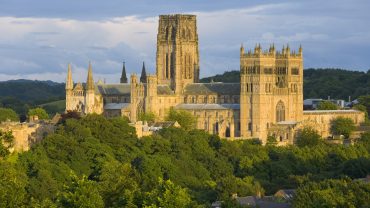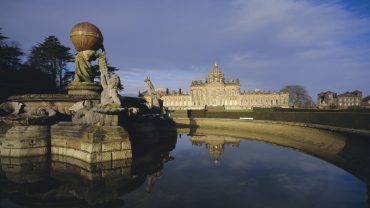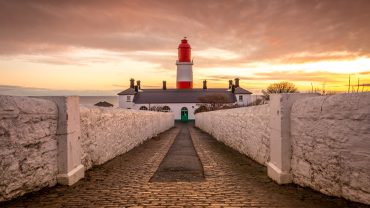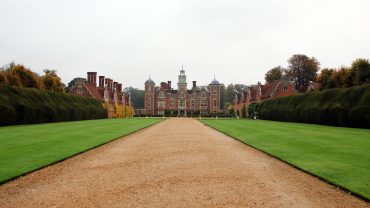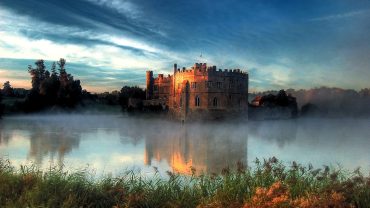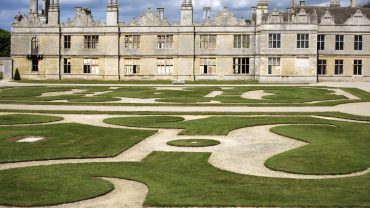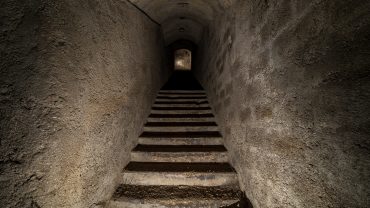Country houses in the UK are traditionally defined as large, elegant residences located in the countryside, outside of major urban centres. They are – or were – typically owned by wealthy landowners or aristocratic families who would often pass these houses down through the generations. Usually part of expansive estates, they were used as retreats from busy city life or as the administrative hubs of agricultural operations.
Unlike fortified castles or the most famous manor houses in England, British country houses were designed for comfort, leisure, and display rather than defence. And while there are no hard-and-fast rules about size, country houses, as you’ll see below, are not like your normal suburban semi!
Let’s take a stately stroll through some of the most impressive and illustrious countryside homes in the UK.
The History of Country Houses in the UK

Wollaton Hall, Nottingham (Credit: Marco Aronica via Getty Images)
The roots of UK country houses stretch back to medieval times, with some of the earliest examples emerging shortly after the Norman Conquest in 1066. Originally, many of these residences were fortified to protect their occupants – usually the lord of the manor – and to assert dominance over the surrounding landscape. In the medieval feudal system, they were also used to undertake the business of the manor, which is why many of them were called manor houses. Yet the first country houses in the UK, as perhaps we’d recognise them today, emerged during the Tudor period.
From the beginning of the reign of Henry VII in 1485 to the end of Elizabeth I’s reign in 1603, the Tudor age was one of relative stability which allowed for unfortified domestic architecture. Many early examples were converted from former monasteries following Henry VIII’s Dissolution of the Monasteries. These homes evolved further during the late Elizabethan and early Jacobean eras with the advent of “prodigy houses,” architect-designed mansions intended to showcase wealth and attract royal visits. Some of the most well-known examples in the UK are Wollaton Hall in Nottingham, Longleat House in Wiltshire, Burghley House in Cambridgeshire, and Hatfield House in Hertfordshire.
By the eighteenth and nineteenth centuries, architects such as Inigo Jones, Sir John Vanbrugh, and Robert Adam transformed country houses in the UK into elegant and often extravagant statements of social status.
Is It A Stately Home or A Country House?

Waddesdon Manor in Buckinghamshire (Credit: sebasebo via Getty Images)
It’s an age-old debate. People sometimes use the term ‘stately homes’ interchangeably with ‘country houses’ however, the former often implies a particularly grand example with architectural or historical significance that’s open to the public. Regardless of terminology, these estates were originally built for aristocrats, members of the landed gentry, or even royals – individuals who could afford lavish construction projects in scenic rural settings. Many remain privately owned and occupied to this day, but others have been repurposed as luxury hotels, event venues, or museums, preserving their architectural legacy while adapting to modern economic realities.
One interesting example is Ascott House in Buckinghamshire. It is one of the more beautiful country houses in the UK but was designed specifically not to be ‘stately’, rather to be in harmony with the surrounding landscape. This contrasts poetically with Waddesdon Manor in Buckinghamshire, which is reminiscent of an extravagantly opulent French chateau.
Britain is replete with stunning country houses that capture the nation’s unique architectural and cultural heritage, so without further ado, here are some of the most famous countryside homes in the UK.
Belton House, Lincolnshire

Belton House in Lincolnshire (Credit: flowersandclassicalmusic via Getty Images)
Belton House, near Grantham in Lincolnshire, is celebrated as one of the finest examples of Restoration-era architecture in England. Built for Sir John Brownlow between 1685 and 1688, this elegant country house epitomises the grandeur of late seventeenth century architecture with its symmetrical design, lavish interiors, and pristine landscaped gardens. Belton boasts over seventy rooms adorned with intricate plasterwork, fine art, and incredible collections of books, tapestries, silver, and paintings.
Belton has been described as ‘the perfect English country house’ and there have been claims (although none verified) that the silhouetted facade of Belton House was used as the icon on British motorway signs directing drivers to all stately homes! Now under the care of the National Trust, Belton welcomes thousands of visitors each year, offering a rare glimpse into the opulent lifestyle of England’s aristocratic past.
Kedleston Hall, Derbyshire

The lavish facade of Kedleston Hall (Credit: TerryJLawrence via Getty Images)
Kedleston Hall, near Derby in Derbyshire, is a stunning neo-classical country house designed by James Paine and Matthew Brettingham, with a later, significant contribution from Robert Adam. Commissioned in 1759 by Sir Nathaniel Curzon, the 1st Baron Scarsdale who called it ‘The Temple of the Arts’, it was built to rival Chatsworth House. Its Palladian style pays homage to ancient Greek and Roman architecture, with grand facades reminiscent of antiquity’s great temples.
Inside, the Marble Hall is a masterpiece of opulence, featuring pink alabaster Corinthian columns and an Italian marble floor. The adjoining Saloon boasts a nineteen-metre-high dome inspired by Roman temples and is used as a sculpture gallery. The house was designed for lavish entertaining rather than as a family home, and in 1977, as one of the most famous British country houses, it was taken over by the National Trust.
Dunrobin Castle, Scotland

Dunrobin Castle, Sutherland, Scotland (Credit: hanskwaspen via Getty Images)
Dunrobin Castle, located near Golspie in Sutherland, is among the most northerly of Scotland’s great houses and one of Britain’s oldest continuously inhabited castles. As the ancestral seat of the Earls and Dukes of Sutherland since the thirteenth century, it embodies centuries of history and grandeur. Originally a medieval fortification, the transformation of one of the most spectacular countryside homes in the UK began in 1835 when Sir Charles Barry, famed architect of the Houses of Parliament, remodeled it into a Scottish Baronial masterpiece with French influences, including conical spires, and gardens inspired by the Palace of Versailles.
The castle boasts 189 rooms, making it the largest in the Northern Highlands. As well as one of the most remarkable country houses in the UK, Dunrobin was used as a naval hospital during World War I and as a boarding school between 1965 and 1972. It was opened to the public in 1973.
Forde Abbey, Dorset

Forde Abbey in Dorset, a true West Country gem (Credit: acceleratorhams via Getty Images)
Commonly referred to as being in Dorset, but with a postal address in Somerset, Forde Abbey is a stunningly beautiful former Cistercian monastery with a history dating back nine centuries. Founded in 1141, it flourished for 400 years as one of England’s wealthiest monastic institutions before being surrendered to the Crown during the Dissolution of Monasteries in 1539. The transformation into one of the most remarkable British country houses began in 1649 under Sir Edmund Prideaux, Oliver Cromwell’s Attorney General, who remodelled it into a Renaissance-style mansion with ornate plaster ceilings and elegant state apartments.
Today, Forde Abbey is one of Britain’s most complete monastic buildings repurposed as a home. Highlights include the oak-panelled Great Hall, and the Grand Saloon adorned with the famous Mortlake tapestries based on Raphael’s designs.
Bodnant Hall, Wales

Bodnant Hall, Wales (Credit: ddjunt via Getty Images)
In the picturesque Conwy Valley looking out towards the stunning Carneddau mountains, Bodnant Hall is an exquisite Georgian mansion encased in blue sandstone by Victorian industrialist Henry Davis Pochin after he bought the estate in 1874. He went on to transform the property into a masterpiece of architecture and horticulture. He collaborated with landscape designer Edward Milner to create Bodnant Garden, now a Grade I listed site spanning eighty acres. The garden features Italianate terraces, woodland areas, and the iconic Laburnum Arch – the longest in the UK.
One of the great UK country houses, Bodnant Hall remains closed to visitors, but the surrounding gardens showcase rare plants from around the world. Notable elements include the Pin Mill, a restored eighteenth-century folly, and The Dell, a gorge garden with waterfalls and exotic trees. In 1949, Pochin’s grandson Henry Duncan McLaren, 2nd Baron Aberconway, gifted Bodnant Garden to the National Trust where it continues to enchant visitors as one of Wales’ most celebrated estates.
Castle Ashby House, Northamptonshire

Castle Ashby House, Northamptonshire (Credit: tbmphoto via Getty Images)
On the original site of a late twelfth or early thirteenth century castellated mansion, the present Castle Ashby House in Northamptonshire is a magnificent Elizabethan prodigy house built between 1574 and 1600 by Henry Compton, 1st Baron Compton. Designed in an E-shaped floorplan to honour Queen Elizabeth I’s reign, one of the most famous manor houses in England features a Palladian façade added in 1624 by Inigo Jones, creating a grand courtyard.
Castle Ashby House has hosted notable royal visits, including Queen Elizabeth I in 1600, King James I in 1605, and King William III in 1695. During the Civil War, it suffered fire damage, and marks of the fire remain visible on window lintels today. The gardens were later redesigned by Capability Brown in 1761, boasting avenues, clumps of trees, and expansive parkland stretching over three miles. The house remains the seat of the Marquess of Northampton and some have suggested it may have been the inspiration for Jane Austen’s 1814 novel Mansfield Park.
Ham House, Surrey
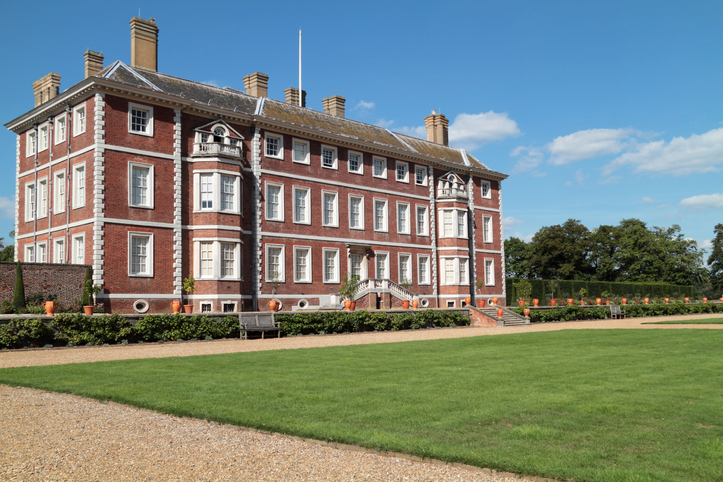
Ham House in Richmond, Surrey (Credit: TerryJLawrence via Getty Images)
A treasure trove of history and design, Ham House on the banks of the River Thames in Richmond, is considered to be one of, if not the, grandest Stuart house in England. Built in 1610 for Sir Thomas Vavasour, it later became the property of William Murray, a close confidant of King Charles I. The house was extensively remodeled in the 1670s by Murray’s daughter, Elizabeth, Duchess of Lauderdale, and her husband John Maitland, transforming it into one of the most impeccable British country houses.
The interiors are adorned with Baroque ceiling murals by Antonio Verrio, intricate Caroline plasterwork, and rare damask hangings. Ham House also boasts one of the earliest surviving libraries in a private residence and features innovations such as sash windows. It has been described as a ‘rare survival of seventeenth-century luxury and taste’.
Castle Howard, Yorkshire

Castle Howard, Yorkshire (Credit: Jeremy Horner via Getty Images)
Castle Howard, in the civil parish of Henderskelfe in North Yorkshire is nothing short of a masterpiece of English Baroque architecture. It’s one of the largest, most magnificent, and famous British country houses and was commissioned in 1699 by Charles Howard, 3rd Earl of Carlisle, although construction didn’t begin until 1701 and took well over a century to complete. It was designed by dramatist-turned-architect Sir John Vanbrugh with assistance from Nicholas Hawksmoor and features a stunning central dome, Corinthian and Doric pilasters, and interiors by Venetian artist Giovanni Antonio Pellegrini.
Castle Howard has endured challenges through the years, including a devastating fire in 1940 that destroyed its dome and staterooms, but restoration efforts continue to preserve its legacy. The house opened to the public in 1952, yet it remains the private residence of the Carlisle branch of the Howard family who have lived there for more than three centuries.
Bowood House, Wiltshire

Bowood House, Wiltshire (Credit: Downhill via Getty Images)
One of the great countryside homes in the UK, Bowood House in Wiltshire is a Grade I listed Georgian house steeped in history and architectural splendour. Owned by the Marquess of Lansdowne, construction started in 1725 by Sir Orlando Bridgeman but it was bought in 1754 by the 1st Earl of Shelburne, who commissioned architect Henry Keene to remodel it. Later, Robert Adam, one of the great Georgian architects, added grand features such as the Orangery and the Diocletian wing, inspired by Roman architecture.
Bowood’s 2,000-acre parkland was transformed by Lancelot ‘Capability’ Brown between 1762 and 1768 into a naturalistic landscape featuring sweeping lawns, wooded plantations, and a mile-long sinuous lake, and the interior includes the Laboratory, where Sir Joseph Priestley first identified oxygen in 1774.


